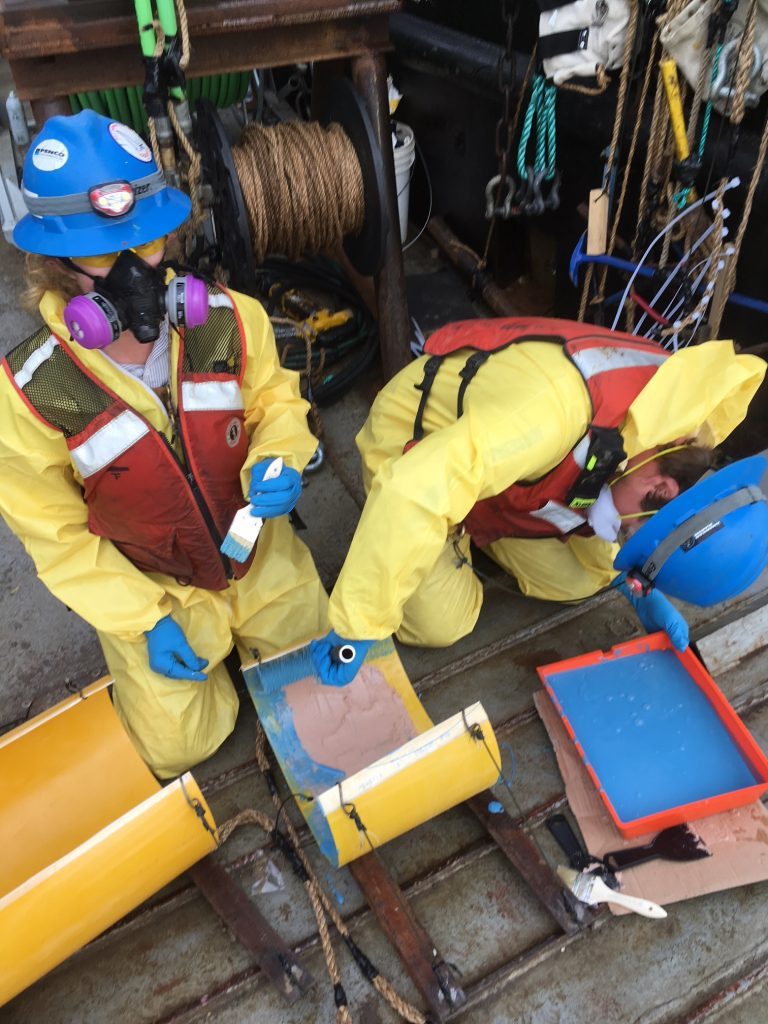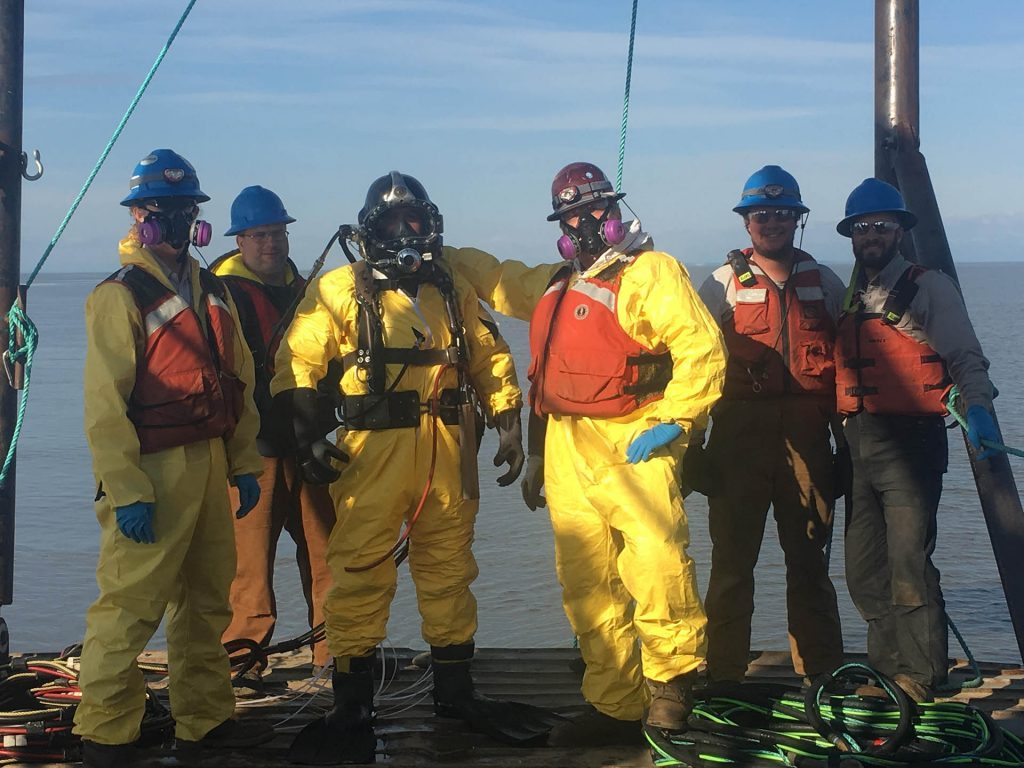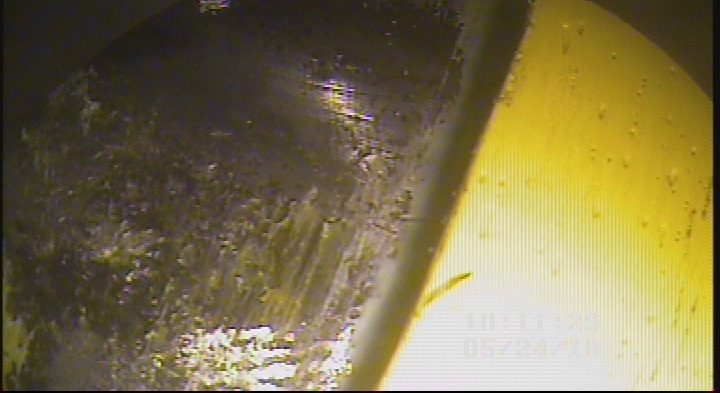Cook Inlet, Alaska, USA
Pipe Details
- Corrosion on multiple girth weld joints on a 10-inch (254- mm) underwater gas pipeline
- 2,785 psi (192 bar) design pressure
- 1,035 psi (71.4 bar) MAOP
- Installed in 43°F (6°C) water
Summary
- A diver applied SnapWrap to address corrosion on multiple girth weld joints on a 10-inch (254- mm) underwater gas pipeline
- The water temperature at the work site was 43°F (6°C)
- The diver installed the SnapWrap composite sleeves, working with zero visibility
- A new tool was designed to allow the diver to install long sleeves without assistance
- Nearby pipelines created tight clearance on the installation area
- Work took place during a limited time window dictated by tidal activity
- Installed in 43°F (6°C) water
- Contour WA was installed to protect the line around the repair from impact
- No welding was required
Maintaining pipeline integrity in exacting environments poses significant challenges, particularly in high-traffic areas offshore. When multiple girth weld joints on a 10-inch (254- mm) gas pipeline in Cook Inlet, Alaska, needed to be repaired, there were a lot of variables that needed to be taken into account. In addition to the marine traffic in the inlet, this repair was complicated by a diver in cold conditions, with zero underwater visibility at the repair site 100 ft (30.5 m) below the surface, very little clearance between the pipelines, and a work window dictated by the tides. There was also a desire to limit the number of divers so that only one person would be in the water to make the repair.
The 10-inch (254-mm) pipeline was coated with concrete except for a number of 24-inch to 36-inch (610 mm to 914 mm) sections where there were girth welds. There were 20 bare weld joints that had experienced external corrosion. Although the welds themselves were free of concrete, because of the thick coating on the rest of the pipe, there were some areas of the line where the clearance was only 2 inches (51 mm).
The owner wanted a solution that would not require the pipeline to be moved and would deliver performance at the maximum operating pressure (MAOP) of 2,785 psi (192 bar). The installation variables and the required specifications led the CSNRI team to suggest SnapWrap, a multi-layered system made of high-strength, corrosion-resistant fiberglass composite split sleeves. It is installed with a high-performance adhesive and a filler material without the need for cutting or welding and can be installed in areas with tight access.
Training was carried out in Houston for the diver who would perform the SnapWrap repair during a weather window in late May into early June, when the water temperature in the inlet would be approximately 43°F (6°C), the application temperature minimum threshold for the composite repair.


A barge carried the diver and support team to the worksite, where the installation was scheduled to take place during slack tides, which occur every six hours, giving the diver bottom time of approximately 25 to 40 minutes. Because the tide flow deposits glacial silt, the diver would need to clean the pipeline before each step of the installation to be sure the adhesive function as needed to properly secure the Snap Wrap to the damaged area of the pipeline.
As the installation began, it became apparent that placing the SnapWrap on the pipe with zero visibility would be difficult following the normal installation protocol. This led to the development of a tool the diver could use to place the repair sleeves singlehandedly on the pipeline without being able to see the repair area.
For each dive, the installer inspected the pipe for access and prepared the surface for installation, then loosely installed band clamps above and below the repair area.
Picking up a repair sleeve from team members on the barge who had applied the filler/adhesive material, the diver descended with the sleeve and used the specially designed tool to place the first snap wrap sleeve on the pipeline, orienting the seam 180 degrees from the primary defect and tighten it to extrude the filler.
Wiping the excess filler from sides of sleeve, the diver moved the band clamps to use again on the next repair, cleaned excess hardened adhesive from the outside surface of snap wrap sleeve and returned to the surface to pick up the next prepared sleeve. The diver repeated this process, placing as many sleeves as possible with seams oriented 90 degrees from each other, inspecting the sleeves to ensure proper curing, and installing Contour WA, a proprietary composite solution with engineered, bi-axial stitched e-glass tape impregnated with a water-activated polyurethane resin, to the remainder of line for impact protection. The diver made as many dives as possible before tide conditions prevented further work.

Following this work program, the diver repaired all the damaged girth welds and restored the line to safe working order. This solution proves the applicability of composite solutions in water in cold conditions and illustrates the adaptability of the technology.

